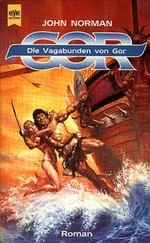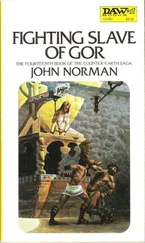“Of course,” had cried Herjellsen, “we are fools! It is phenomenal time we are translating! It is like reaching out twice to touch a moving object and expecting to touch it a second time in the same place one did at first! The equations must be adjusted, relativized!” But this did not prove simple. Primarily it was discovered that the spatial coordinate as well as the temporal coordinate alters. It was as though the blind man were trying to touch two moving spheres, each different, and touch each at precisely the same place that he had touched them before. Yet Herjellsen and William worked, and the 1180 was modified, programmed, remodified, and reprogrammed again and again. Gradually, a pattern, though one of fantastic complexity, began to emerge. The second collection, a piece of seared shale, occurred a month after the branch. From that time on collections became more frequent, more predictable. Herjellsen could not tell to what time or place his coordinates corresponded, only that they were successful in generating collections. It was as though he printed a number, possibly meaningless, on a card, and then mailed it. If there was an answer it had been an address, somewhere; if there were no answer, then he did not know if it had been an address or not; it had perhaps been nothing; it had perhaps been an address that had not responded; Ire did not know.
Toward the end of the first series of experiments notable results had been achieved. Collections had become statistically predictable. In one experiment a fragment of rock had been obtained; in the subsequent experiment its matching counterpart; this had indicated a refinement of considerable delicacy, the complexity of which would not have been possible without the modified 1180 device; the calculations, by hand, might have consumed years. It was as though the blind man were finally learning to touch the two spheres, in precisely the same places, on subsequent attempts. He did not know what places he touched, but he knew that whatever places they might be he could touch them at least twice. While William, aided by Herjellsen, fought to refine the mathematics of the Herjellsen conjecture, Gunther, partially working under the instruction of Herjellsen, partially improvising relays and circuitry, gave his attention to the sophistication of the amplifying mechanism. Specimens had been collected generally in a shattered, or seared condition, almost as though torn through atmospheres and exploded from one dimension into another. For reasons that were not clear to William and Gunther at the time, these effects were not found acceptable by Herjellsen. Coils to the translation cubicle were multiplied. Significantly, generator power was reduced; the distributions and focuses of power, as it turned out, were more significant than its amount. Most significant of all, of course, was the strange mind of Herjellsen. Though abetted and sharpened by the equations of William, though reinforced by the genius and electronics of Gunther, it was that mind, and that mind alone, that could reach out, that had the power to reach out and touch, for an agonizing moment, the reality. It is not known how we can move our hand, and yet we understand that it can be done, and do it; it is not clear whether Herjellsen was perhaps a mutant, or that he, of all men to his time, alone intuited his power, and understood what might be done; it is not known, so to speak, whether Herjellsen discovered a hand that other men do not possess, an instrument, a power, or that he was the first to discover what all men might, though it lie forever dormant, possess. The infant, weeping, alone, wished the bright toy, and lo, a hand, to his astonishment and pleasure, his own, reached forth, and drew it to him. He had learned to will, and grasp. He would never forget this. He would never understand it, but neither would he forget it. It was his now, this power.
“We will succeed!” had cried Herjellsen.
Late in the first series of experiments the success had come.
There had appeared on the floor of the translation cubicle, in a bit of water, fresh and cold, a handful of ice moss. Herjellsen had entered the cubicle, and, on his knees, had lifted it in his hands. It was delicate and cold. Each fiber was intact, and perfect. Herjellsen had wept. William and Gunther had not understood his emotion.
He had looked at them, from within the cubicle, the ice moss cupped gently in his hands. “We will succeed,” he had wept. “We shall succeed.”
Herjellsen’s interests, for no reason that was clear to either William or Gunther, were narrow. Only certain categories of equations were utilized by him, and within these categories there was investigation in fantastic depth and subtlety. It was as though Herjellsen were seeking some particular reality, some destination, some special address in the vastnesses and wastes and mysteries of the reality.
It was with a startled, and eerie feeling, that they had heard his shriek of pleasure in the experimental shack.
In the cubicle bad lain the Herjellsen artifact, the rounded, chipped, roughly polished stone; it weighed 2.1 kilograms. It was a tool, a weapon.
“Gentlemen,” bad said Herjellsen, “the first series of experiments is herewith concluded.”
“I still suspect Herjellsen is a charlatan,” said William.
“It is possible,” said Gunther.
“Yet-the artifact,” said William. “It seems genuine.”
Hamilton had seen the artifact many times. It was commonly kept in the computer building.
“You believe,” asked Hamilton of William, “that there is some trick involved in all this?”
“That certainly seems plausible,” said William, looking out the window of the Land Rover. The glass was rolled down. His face was dusty, particularly the right side. There was dust, too, on his sunglasses.
“It takes years to make such an object,” said Hamilton, archly. “Herjellsen couldn’t have made it, could he?”
“It does not take years to make such an object,” said Gunther. “Flint is a soft stone. It can be worked swiftly. Such an ax could be chipped by a skilled craftsman in forty minutes, and polished in an hour.”
“How would you know?” asked William..
“It is simply a matter of the physics of the stone,” said Gunther. “The physics of the stone makes the answer clear.”
“I had always thought it would take a long time,” said Hamilton.
“You are incorrect,” said Gunther.
“Oh,” said Hamilton.
“If such a stone can be worked quickly,” said William, “and I shall take your word for that, then it seems quite likely that the Herjellsen artifact was manufactured by our dear colleague, the amiable professor himself.”
“I do not regard that as likely,” said Gunther.
“You realize what you are saying,” said William, slowly.
“Precisely,” said Gunther.
“It could have been stolen,” suggested Hamilton.
“The stone is fresh,” said Gunther. “It bears no signs of age.”
“What better evidence that it is a fake?” asked William.
“What better evidence that it is genuine?” asked Gunther.
Hamilton shivered.
“If the Herjellsen conjecture is correct,” said Gunther, “the stone should be as it is, fresh, clean, newly worked.”
“That is true,” said William.
“Herjellsen, did he not,” asked Hamilton, “once stole such a stone.” She said nothing more. Gunther, when speaking to her of Herjellsen, had told her this among other things. Hamilton did not mention that it had been stolen from a museum in Denmark. A guard had been killed in the theft.
“He stole it to study it,” said Gunther.
“Why should he wish to do that?” asked William.
“I do not know,” said Gunther. “Perhaps he wished to conduct tests. Perhaps he wished only to know it thoroughly, so that he might recognize such an artifact again.”
Читать дальше












